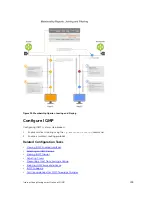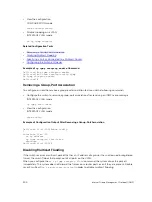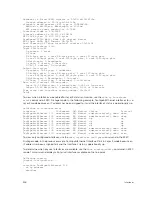
Enabling IGMP Immediate-Leave
If the querier does not receive a response to a group-specific or group-and-source query, it sends
another (querier robustness value). Then, after no response, it removes the group from the outgoing
interface for the subnet.
IGMP immediate leave reduces leave latency by enabling a router to immediately delete the group
membership on an interface after receiving a Leave message (it does not send any group-specific or
group-and-source queries before deleting the entry).
• Configure the system for IGMP immediate leave.
ip igmp immediate-leave
• View the enable status of the IGMP immediate leave feature.
EXEC Privilege mode
show ip igmp interface
View the enable status of this feature using the command from EXEC Privilege mode, as shown in the
example in
IGMP Snooping
IGMP snooping enables switches to use information in IGMP packets to generate a forwarding table that
associates ports with multicast groups so that when they receive multicast frames, they can forward them
only to interested receivers.
Multicast packets are addressed with multicast MAC addresses, which represent a group of devices, rather
than one unique device. Switches forward multicast frames out of all ports in a virtual local area network
(VLAN) by default, even though there may be only some interested hosts, which is a waste of bandwidth.
If you enable IGMP snooping on a VLT unit, IGMP snooping dynamically learned groups and multicast
router ports are made to learn on the peer by explicitly tunneling the received IGMP control packets.
IGMP Snooping Implementation Information
• IGMP snooping on Dell Networking OS uses IP multicast addresses not MAC addresses.
• IGMP snooping reacts to spanning tree protocol (STP) and multiple spanning tree protocol (MSTP)
topology changes by sending a general query on the interface that transitions to the forwarding state.
• If IGMP snooping is enabled on a PIM-enabled VLAN interface, data packets using the router as an
Layer 2 hop may be dropped. To avoid this scenario, Dell Networking recommends that users enable
IGMP snooping on server-facing end-point VLANs only.
Configuring IGMP Snooping
Configuring IGMP snooping is a one-step process. To enable, view, or disable IGMP snooping, use the
following commands.
There is no specific configuration needed for IGMP snooping with virtual link trunking (VLT). For
information about VLT configurations, refer to
.
• Enable IGMP snooping on a switch.
CONFIGURATION mode
ip igmp snooping enable
Internet Group Management Protocol (IGMP)
303
Содержание Z9000
Страница 1: ...Dell Configuration Guide for the Z9000 System 9 7 0 0 ...
Страница 80: ...grub reboot 80 Management ...
Страница 128: ... 0 Te 1 1 Te 1 2 rx Flow N A N A 128 Access Control Lists ACLs ...
Страница 436: ...Figure 50 Inspecting Configuration of LAG 10 on ALPHA 436 Link Aggregation Control Protocol LACP ...
Страница 439: ...Figure 52 Inspecting a LAG Port on BRAVO Using the show interface Command Link Aggregation Control Protocol LACP 439 ...
Страница 440: ...Figure 53 Inspecting LAG 10 Using the show interfaces port channel Command 440 Link Aggregation Control Protocol LACP ...
Страница 491: ...Figure 70 Configuring OSPF and BGP for MSDP Multicast Source Discovery Protocol MSDP 491 ...
Страница 492: ...Figure 71 Configuring PIM in Multiple Routing Domains 492 Multicast Source Discovery Protocol MSDP ...
Страница 496: ...Figure 73 MSDP Default Peer Scenario 1 496 Multicast Source Discovery Protocol MSDP ...
Страница 497: ...Figure 74 MSDP Default Peer Scenario 2 Multicast Source Discovery Protocol MSDP 497 ...
Страница 498: ...Figure 75 MSDP Default Peer Scenario 3 498 Multicast Source Discovery Protocol MSDP ...
Страница 760: ...Figure 100 Single and Double Tag TPID Match 760 Service Provider Bridging ...
Страница 761: ...Figure 101 Single and Double Tag First byte TPID Match Service Provider Bridging 761 ...






























